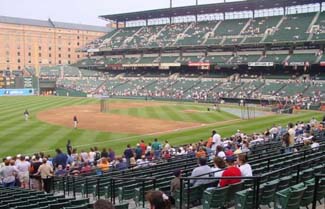|
In Baltimore, Maryland
the final stages have recently been completed in the
demolition of Memorial Stadium. The ground where it once
stood will be cleared and redeveloped, and someday soon
it will be home to a retirement community. There are bricks
for sale. The seats and other items have been auctioned
off or shipped to museums. The stainless steel letters
that formed the homage to veterans at the main entrance
will be moved and displayed. This will be the extent of
its posterity.
The structure itself has
been in retirement since 1998 when the Baltimore Ravens
left for greener pastures. The Orioles haven’t played
there since 1991, and the only other recent tenants were
Canadian football and Double-A baseball. To be fair, this
is as it should be. Memorial was old (built in 1954),
and it simply did not provide the comforts (or sight lines)
fans paying $40 or $50 a ticket deserve. Its time had
passed.
So the argument in favor
of redevelopment is that the land itself is valuable,
and that the city and community do not benefit from having
a giant, unused mass occupying it. There is some truth
to this, of course. But there’s something else to
it, something that even many preservationists fail to
mention. It’s not simply that history gets cheated
by altering the space, it’s that by removing the
structure the history is fundamentally altered.
Memorial Stadium was home
to some of the greatest football and baseball teams the
world has ever known. Johnny Unitas, Art Donovan, Cal
Ripken, Brooks Robinson, Jim Palmer, and a host of other
greats all played there. Between the Orioles and Colts
the stadium was home to six championship teams. These
facts are significant in their own right, but they extend
beyond themselves. Sports (and sporting events) are a
yardstick of the culture. Every major historical event
has a touchstone in sports that reveals something more.
The fact, for example, that Willie Mays took time off
from his playing career to spend time in the armed forces
is a window into the values of that time. Sports have
a way of serving as shared memory for disparate groups
of people whose paths might not otherwise have crossed.
 |
That history does not disappear
when a stadium gets closed down the same way it doesn’t
disappear when a player retires. It’s the natural
progression, and certainly nobody will deny that Oriole
Park at Camden Yards is one of the premier stadiums in
baseball and a significant upgrade. The difference here
is that a stadium doesn’t have to die the way a player
eventually will. People pass on, and the history they
knew goes with them. With physical structures such as
a stadium that history does not have to disappear.
Take, for example, Washington
D.C.’s RFK Stadium. While it has been several decades
since baseball was played there, and several years since
football, the structure itself remains. It is now home
to professional soccer and the odd festival or concert,
but it hasn’t really changed. The names of great
athletes who once played there still grace the facade,
and to be there is to consider the past. If and when RFK
stadium is torn down, that physical history will go with
it.
Dirt and air do not constitute
space. When you move into a house you do not consider
it yours until it is filled with your things, and it is
in much the same way that events are bound to the brick
and concrete that surrounded them. Memorial Stadium, every
event ever held there, every fan who ever attended a game
there, and every piece of history tied to it are all compromised
by the decision to replace it with a waiting room. Worst
of all, there’s no good reason for it.
One of the proposals for
the site was a park which would preserve large parts of
the structure as well as its function as a veteran’s
memorial. Another called for it to be a mixed-use commercial
center built into the structure itself. With a little
bit of thought one could imagine several such scenarios
where the structure is preserved while the space is put
to use. It’s a problem that vexes urban planners
all over the country, and they almost always make the
wrong decision. If a given structure is fundamentally
sound and historically significant there is never a good
reason to choose demolition over modification. This is
doubly true with stadiums. Brick by brick we’re giving
away vital links to experience.
|